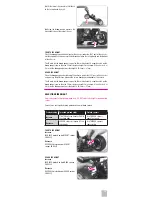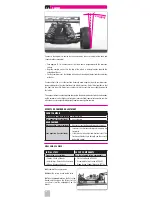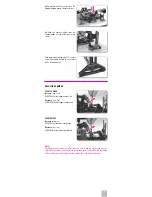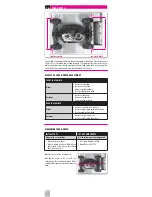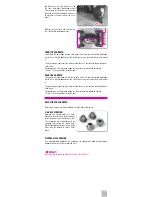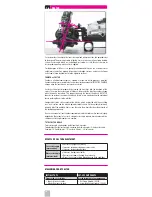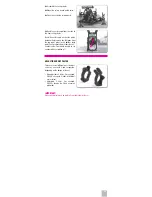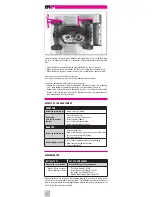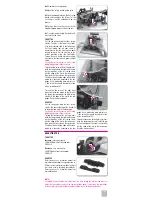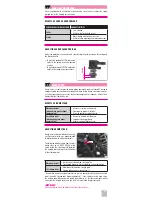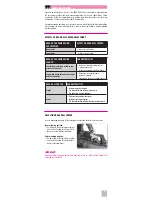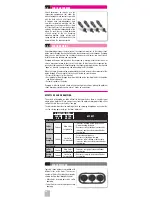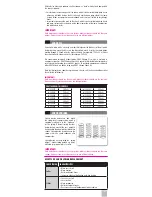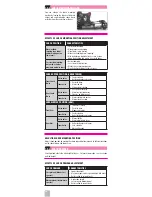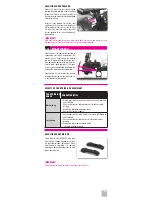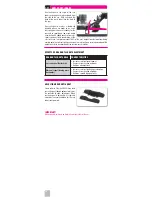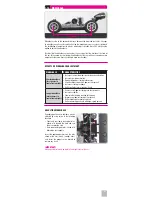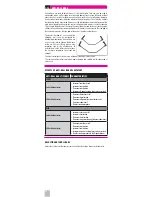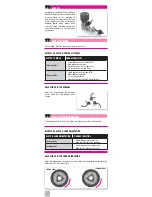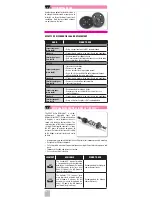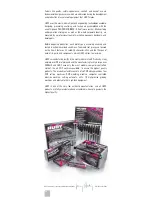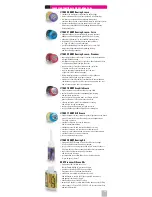
27
Different size holes also produce an effect known as “pack” which affects how quickly
the shocks respond.
• Smaller holes increase the pack of the shock, which is better suited to big-jump tracks
where you will often land on the fl at surface & not the down ramp side of the jump.
It slows things on compression and rebound, and is not well suited to very bumpy
tracks.
• Larger holes decrease the pack of the shock, which is better suited to bumpy tracks
and jump sections where you land on the down ramp side of the jump. Compression
and rebound are faster.
IMPORTANT!
Both front shocks should use the same pistons; both rear shocks should use the same
pistons. However, front & rear shock pairs may use different pistons.
SHOCK OIL
Shock oil is rated with a “viscosity” number that indicates the thickness of the oil, which
determines how much the oil resists fl owing and how much it resists the shock piston
moving through it. Shock oil with a higher viscosity (for example, 1000 cSt) is thicker
than shock oil with a lower viscosity (for example, 500 cSt).
We recommend using only highest-grade XRAY Silicone Oil, which is available in
numerous viscosities. XRAY Silicone Shock Oil is specially formulated to be temperature-
resistant and low-foaming for use in XRAY shocks. To be able to compare your setup with
other XRAY drivers, we advise using only XRAY Silicone Shock Oil.
Note that typically you should use piston hole sizes to suit the track conditions rather
than alter the oil viscosity.
IMPORTANT!
Both front shocks should use the same oil; both rear shocks should use the same oil.
However, front & rear shock pairs may use different pistons.
XRAY PREMIUM SILICONE OIL
# 359210
100 cSt
# 359245
450 cSt
# 359215
150 cSt
# 359250
500 cSt
# 359220
200 cSt
# 359260
600 cSt
# 359225
250 cSt
# 359270
700 cSt
# 359230
300 cSt
# 359280
800 cSt
# 359235
350 cSt
# 359290
900 cSt
# 359240
400 cSt
# 359301
1 000 cSt
SHOCK SPRINGS
Spring tension determines how much
the spring resists compression, which is
commonly referred to as the “hardness”
of the spring. Different spring tensions
determine how much of the car’s weight is
transferred to the wheel relative to the other
shocks. Spring tension also infl uences the
speed at which a shock rebounds after
compression.
Spring tension is usually rated in a “spring
weight” ; higher spring weights are stiffer,
while lower spring weights are softer.
IMPORTANT!
Both front shocks should use the same springs; both rear shocks should use the same
springs. However, front & rear shock pairs may use different springs.
EFFECTS OF SHOCK SPRING REPLACEMENT
SHOCK SPRING CHARACTERISTICS
Softer
• More chassis roll
• More traction
• Better on bumpy tracks
• Increases chance of bottoming out when landing
Stiffer
• Less chassis roll
• Less traction
• More responsive
• Better on smooth tracks
• Decreases chance of bottoming out when landing

